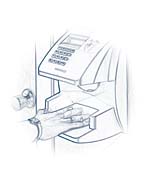Among them is Richard Sedivy, marketing director at Doorking Security Systems, Inglewood, Calif., who sees the most current technology trends in access control as more smart cards, integration, and biometrics.
“Smart cards, integration and biometrics have been buzz words for a couple of years now,†Sedivy says. “Among others, there are two distinct market forces that have created these trends: homeland security and employers’ responsibilities to better protect their employees. These trends are apparent in small businesses, more of which are employing some sort of control system,†Sedivy says.

CONVERGENCE OF IT & SECURITY
Part of the reason that more and more small businesses are able to employ electronic access control products and systems is the advancement of network technology and its nearly universal adoption across the spectrum of business and industry.“In the past, physical security was paramount. The previous trends shaping the industry were evolutions in how to maintain security of facilities and people. Now, logical security changes the equation. It presents opportunities to not only secure a client’s information-based assets, but add efficiencies in how they do business,†says John Paradis, head of North American sales for Fargo, Eden Prairie, Minn. “The industry is seeing a convergence in physical and logical access control.â€
Paradis says that most organizations have addressed the security threats against their facilities and people. But a holistic approach to controlling access means also looking at preventing unauthorized access to computer systems, preventing the introduction of unauthorized software, and preventing unauthorized access to company servers.
“Breaches of security in these areas can be just as devastating to an organization as physical security threats,†Paradis says.
In response, dealers and integrators need to be selling secure access with maximum efficiencies. Paradis says that it’s imperative that their clients understand how the technology that improves their security will also bring greater efficiency in operations.
“Plus, as an added benefit for the dealer, when the need for physical access, logical access, and operational efficiencies are all combined in one solution, the revenue generated from any one client can grow exponentially,†Paradis says.
Deb Spitler, chairperson of the Access Control Industry Group for the Security Industry Association (SIA), Alexandria, Va., agrees: “Systems that are IT-friendly and/or plug-and-play provide end users with the ability to leverage their investments in existing systems while upgrading to new systems, components, or applications. It is no longer necessary to replace an entire system to add new functions.â€
According to Tony Hanseder, vice president, product marketing, HID Corp., Irvine, Calif., this trend began a few years ago as manufacturers began adding TCP/IP to their panels.
“This was one of the first applications within the overall trend. IP-based cameras are another application. The trend will continue down to the reader level,†Hanseder says. This is more of a market trend versus a technology trend, the latter of which was typically the industry driver. We now have end users driving the market demand for IT-centric access control. Sure, the widespread adoption of the Internet has created the infrastructure to give rise to an IP-centric backbone, but the voice of the customer is ultimately going to drive this trend,†Hanseder says.
Additionally, Spitler says that providers of IT-centric solutions are beginning to express an interest in the traditional security market. As these companies begin to enter the access control field, they will bring IT-based solutions, including web-based software and greater use of the company network, to the traditional security field. “These providers will change the way access control systems are sold, installed, and used,†Spitler says.

Summoning smart cards
Smart cards, too, will change the way that access control systems are sold, installed and used because they are flexible enough to provide security and other benefits at multiple points of contact.“The technology component of the trend toward IT convergence is the movement away from mag stripe cards towards smart cards,†Paradis says.
He adds that in addition to upping the level of everyday computer security, the proliferation of viruses and hacker breaches is forcing companies to better secure their data. “It’s easy to spot someone walking out the door with the company’s physical assets, but the covert nature of stealing an organization’s logical assets can be difficult to track, even as it becomes easier to do. Plus, through regulations such as HIPPA, the government is demanding that private data be protected,†Paradis says.
In addition to providing access to physical and logical facilities, Paradis says that smart cards become stored value cards for vending machines and cafeterias, as well as a punch card for time and attendance, and a parking pass.
In other words, the access control card is no longer used just for access control.
Additionally, according to Spitler, the enhanced data transfer speeds of 13.56 MHz technology allows for more data to be quickly and securely transferred.
“The desire to use multiple applications on a single card is driving users to request more storage space on the card. Although most users do not use the card’s memory to its fullest capacity, it is the theory that ‘bigger is better,’†Spitler says.
She says that the trend towards using the access control card for multiple applications is being driven by early adopters who believe that a single card can economically be used for many secure applications throughout the enterprise.
“This gives new value to the access control card,†Spitler says. The card moves from being a simple card to being a credential.
“The access control card will no longer be used solely for access control and as a photo ID badge. The card will be used for a variety of applications throughout the enterprise, including PC secure log-on, cashless vending, the storage of personnel records, etc. This will change the way the enterprise looks at and handles the whole subject commonly referred to as ‘identity management,’†Spitler says.

Bring on Biometrics
Along with smart cards, biometrics are poised to greatly expand the breadth and depth of access control products and systems.“Along with RFID, biometrics are showing tremendous potential and acceptance because of the acute awareness of today’s security needs as a result of 9/11, homeland security initiatives, and HIPPA,†says Herb Albinus, product manager, ADI, Melville, N.Y. “Smarter technology allows for simpler and more reliable installations. Also, there is more general market awareness now as compared to pre-September 11.â€
Spitler says that along with 13.56 MHz technology, biometrics is a good example of how RFID is being applied in today’s markets.
“With biometrics, the need to control information in a centralized database can be overwhelming or even impossible. The ability to store information on a card and to change that information through read/write capabilities allows users to walk around with their own personal database. For biometrics, right-to-privacy advocates are most appeased with the use of the biometric information contained solely on a card that they carry,†Spitler says.
This overlapping of security technologies is another notable development.
“Biometrics will play a greater role as the technology becomes more easily integrated into access control programs. The concept of ‘layered security’ will become even more important,†Paradis says. “By layering card technologies with biometric applications with CCTV surveillance products and more, dealers can deliver solutions that will keep their clients two steps ahead of forgers and hackers.â€

Operating Open Systems
Security professionals must deliver what end users demand, and what end users are increasingly demanding in access control technology is open systems.“The trend toward open, non-proprietary systems was created by end users who wanted the ability to control their own destiny,†Spitler says. “End users have grown to be more technically savvy and thus require the ability to build their own systems from elements they find to be most conducive to their business environments. In addition, end users feel that by having open systems and components, there is more ability to use the combination of vendors and/or products that are deemed to bring the best value to the organization.â€
Hanseder agrees that a prevailing trend in access control is open systems, not those based on proprietary formats, but those based on IT-friendly solutions that are network-compatible (TCP/IP).
“This preference for plug-and-play is directly driven by the advent of the convergence of IT and security. As convergence continues, IT departments will increasingly require that physical devices be IT-friendly and that access control readers and panels be network-accessible,†Hanseder says.
Further, Hanseder says that the market demands creating these trends include the end user cost and inflexibility associated with legacy equipment. End users are driving demand for open systems to free them from the bounds of specific manufacturers.
LOOKING FORWARD
On the R&D side, some in the industry believe that the anticipated access control frequency will jump to over 2 GHz in the near future. With an increasing number of applications and declining costs for better chips, the need to transfer more data at a faster rate will continue.“Also, it is likely that there will be additional connectivity or interfacing between the access control software and other business management software,†Spitler says. “For example, if the access control software, the human resource software, the IT software, etc., were intertwined, management of a wide range of systems would be easier. In addition, the system would provide more reliable information to the system users about the status of the enterprise Access control is likely to fall into the full scheme of ‘identity management,’ which today is offered by companies such as Hewlett Packard, IBM, etc., who are outside of the traditional physical security space.â€
In addition to flexibility and speed, future incarnations of access control technologies will likely demonstrate even more web-based solutions and IT-friendly access control products.
“Simply said, some believe that both hardware and software solutions will become purely IT centric,†Spitler says.
Sidebar
Upgrading Dealers and Integrators
According to ADI product manager Herb Albinus, “In many ways, dealers’ and integrators’ responses to the access control effort has not changed. Dealers and integrators can stay informed by reading trade magazines, reviewing product catalogs, and seeking the training they need to sell and install these products.â€While these industry staples will continue to be in demand, changes in access control technologies will continue to make more demands on dealers and integrators.
“Dealers and integrators need to view themselves no longer as access control specialists, but as security consultants,†says Jon Paradis, head of North American sales for Fargo, Eden Prairie, Minn. “For long-term viability in this industry, they need to be able to address a client’s complete security concerns.â€
Paradis says that dealers and integrators can prepare themselves for the convergence of logical and physical access in two ways:
1.“When they are working with clients in developing/ designing an access control program, they should work to include the IT director, even if there is push-back from the security staff. If a client is upgrading or re-evaluating their access control system, then the time is right to look at the IT side, as well. This will add to the dealer or integrator’s value as a proactive technology partner with their clients,†Paradis says.
2.“Dealers and integrators need to expand their knowledge and capabilities with regard to the IT side of security. Can their sales and technical staff intelligently discuss the needs and options of logical access in addition to physical? Does the company have the product line to support those client’s needs, or alliances with suppliers of compatible technologies?†Paradis says.


